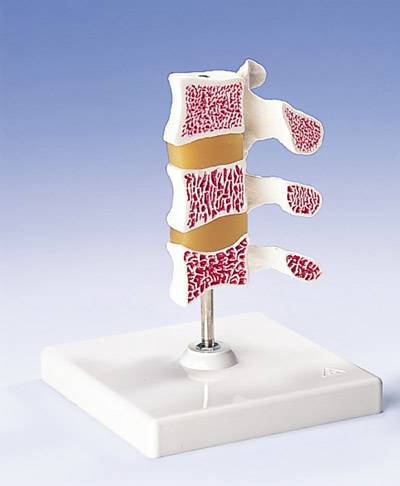Home » Hospital & Durable Medical Equipment » Pros and Cons of Osteoporosis Model Types » Pros and Cons of Osteoporosis Model Types
Pros and Cons of Osteoporosis Model Types
Osteoporosis is a medical condition that is commonly associated with aging, and often undiagnosed until an injury occurs. Since osteoporosis is bone disease that causes internal deterioration of bone tissue, it is virtually impossible for the patient to visualize the condition. In many cases, a fractured hip, wrist, rib, arm, or bone in the spine is the first and only symptom that the patient experiences before the diagnosis. While most patients with osteoporosis are elderly, younger individuals with a history of osteoporosis in the family or those with multiple risk factors are also at risk for this condition.
The use of an osteoporosis model when talking with a patient and his or her family is a wonderful way to provide information in a caring and empathetic way. Since a patient may have difficulty in absorbing all of the information just by listening, an osteoporosis model adds another learning mode to the discussion. Being able to look directly at the anatomy model helps the patient with retention of information both about the disease as well as the possible progression. An osteoporosis model can also be used to demonstrate how various medications and treatment plans can help slow or stop the progression of the disease.
As with any type of tool used in patient environments there are different options on the market. Generally, any type of osteoporosis model will have both good features and some that may not be effective for all types of patients. Knowing which style or type of model works well with various patients is a bit of intuition. Having more than one osteoporosis model also allows for the option to switch models to something that is more effective for a particular individual.
A very common type of osteoporosis model is a disc or cross section model. This is a small sized circular model that has a series of plates that swing out from the back spine of the model to show the four stages of osteoporosis as well as what healthy bone looks like in cross section. This model is very good for patients that are somewhat knowledgeable on the condition and have had a chance to research, read or talk about the condition before consulting with the doctor. The major drawback to the model is that it is somewhat artificial in the design and it is difficult to see the progression in a comprehensive manner. For some patients the movement of the discs in the model can be distracting or even confusing. For staff it is lightweight, very small and an ideal tool to use with many patients.
The other major type of osteoporosis model is the actual physical representation of bone going through the four stages of the disease. The healthy bone section or joint will also be contained in the anatomical model for comparison. While not life-sized the models are large enough to be easy to see and clearly identify the condition. The major drawback to these types of models is that they may also include visual aspects of other related diseases or conditions, which may be confusing to some patients. Overall, they are very practical for staff to use and like the disc type models, are small and easy to store.
MSEC remains dedicated to providing the very best and the very latest in medical supplies and equipment. We never cease to be on the lookout for the latest innovation that will benefit both our many clients and the patients they dedicate their lives to caring for. If you have any difficulty finding your choices in our vast inventory, call our customer service at 1-877-706-4480 to speed up your order or to make a special request. We are always happy to help you.













 Unit: single
Unit: single




